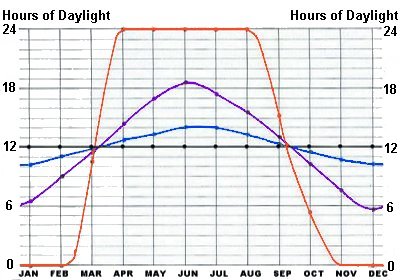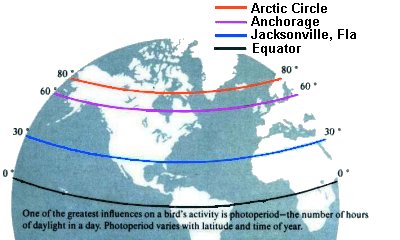|
Monthly Changes in Daylight Hours |
|

|

Return to Affect of Climate on Birds |
| Daylight Hours by Month for Latitudes | Locations of Latitudes |
|
Although we cannot predict all aspects of climate -- the precise temperature or the direction and force of the wind on a certain day, for example -- seasons and the progression of night to day are predictable. We know that it is cold in certain seasons and warm during others. We know that June 21 is the longest day and December 21 is the shortest day of the year. We know that in the Arctic there are 24 hours of darkness for a time in winter and 24 hours of daylight for a time in summer. This information is predictable because of the regularity of the earth's rotation around the sun and the earth's spinning on its axis. In temperature zones, the changes in photoperiod provides birds, flowers, and humans with a natural calendar. The changing photoperiod is particularly important to migrating birds; it stimulates the return migration, the development of reproductive organs, and the initiation of courtship, nest-building, and egg-laying. In tropical environments the photoperiod is relatively constant --- 12 hours of daylight and 12 hours of darkness. In the tropics nature provides other cues, such as the beginning of the rainy season. Changes in photoperiod do more than provide natural cues. The longer days of summer allow adult birds to feed their young for a longer period each day. A shorter period of night means a shorter period of fasting for young birds. Therefore, birds at northern latitudes can often raise more young than birds of the same species farther south. In the same manner, however, birds at northern latitudes may not be able to spend the winter where they breed, even if they can tolerate the cold. They cannot eat enough during the hours of daylight to sustain the high rate of metabolism they need to survive the long, cold night. Other factors influence birds' activities, but most relate in one way or another to photoperiod. |
|